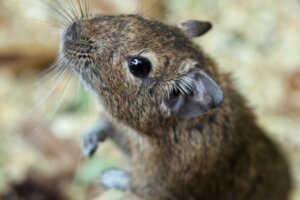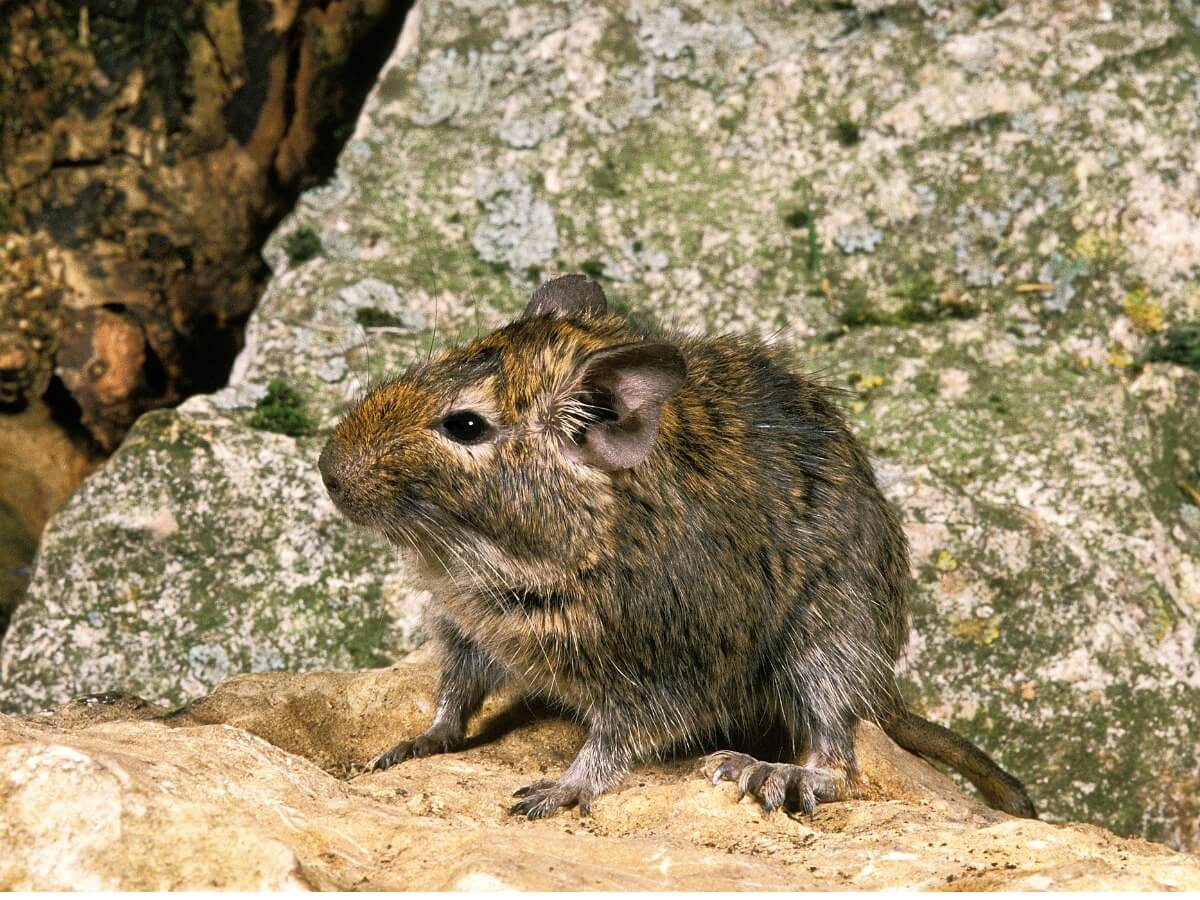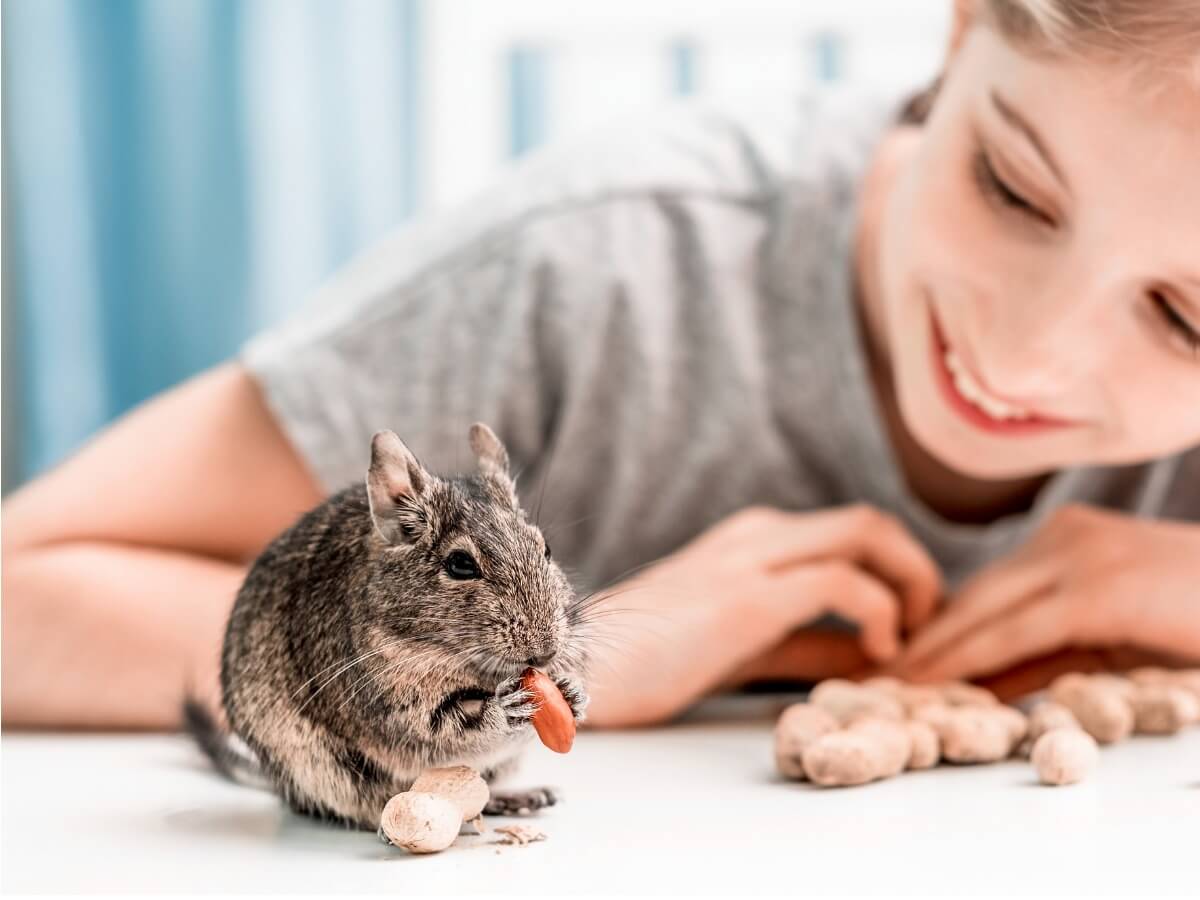Get to Know the Degu!

Also known as “tapias mouse” or “Chilean squirrel”, the star of this article is a small histricomorphous rodent mammal that lives in semi-arid areas of Chile. Here you’ll be able to get to know the behavior of the degu (Octodon degus) in its daily life and you’ll discover why it has become so popular in homes as a pet.
These animals can live from 4 to 6 years and feed mainly on grasses, leaves, and seeds. Thanks to their skillful front legs (similar to small hands), they’re able to select and manipulate their food and dig their burrows; they’re also endowed with great intelligence.
Degu behavior
The degu spends most of the day roaming the soils of its area in search of food, and resting at night. It’s a gregarious species with a nervous and timid character, although among each other they’re affectionate. In the following sections, you can learn about its behavior in the different areas of its life.
Exploratory behavior and surveillance
The degu has a strong exploratory instinct, which is why it spends much of its time outside the burrow to recognize its surroundings. During the day, coordinated groups of these rodents go out in search of water and food. While some of them venture into unfamiliar terrain, the others keep watch to warn them in case of danger.
The amount of effort put into policing is greater the more open the space they explore. In case of attack, they mobilize in the nearest shelter to reorganize and flee.

Circadian cycle
Degus are highly dependent on the cycle of light and dark, as their main peaks of activity are at dawn and dusk. With the change of daylight hours throughout the seasons, their habits change, such as the time they spend outside the burrow. The environmental temperature also influences their activity, since they go out at times when the heat or cold are more suitable for them.
Degu social behavior
Degus are strongly gregarious animals. In nature, they can be found in colonies of 5 to 10 individuals, made up mostly of filially related adult females (mothers, daughters and sisters, also aunts and cousins). The males are less numerous and there are usually no more than 3 per group.
The underground burrows they live in are dug in a coordinated way. The adults communicate by means of vocalizations, to make a chain in which each individual removes the earth that the one in front excavates. Cooperative behavior is very common in this species in different aspects of its life.
The degu is a mammal with a prolonged childhood, as it has a complex communication and social system that learns with the company of other juveniles through play. The communities are organized in a hierarchical way, which allows them to establish an order when it comes to eating and reproducing.
Degu communication
In this section, you’ll see how each sense fulfills its own function in communication. The degu’s behavior relies on the very integration of all these ways of transmitting messages, making it even more complex.
Visual communication
Their sight is mainly used for reading body language. Through postures, degus communicate moods, pain, illness, predisposition to mating, and much more.
Being twilight animals, they have a good sense of sight. They have color vision, although only with two types of cones: ultraviolet and green. This first wavelength, invisible to humans, also influences communication, as the hair on their belly and their urine reflect ultraviolet light intensely.
Olfactory communication
Through smell, the specimens receive information on the health (or reproductive) state of their congeners, in addition to their presence. Among males, it has also been documented that they use sand baths to impregnate certain areas with their scent, as a mark. Females, on the other hand, don’t show this behavior in such an established way.
Hearing and vocalization
The auditory system of these rodents is also well developed, as vocalizations are their main means of communication. They’re able to distinguish the different members of their group through the timbre of their voice.
15 types of vocalizations have been categorized in the degus, with variations within each one according to the context, hierarchy, sex, and season of the year. Some categories of sounds are unique to mother-child relationships, and the young learn the entire repertoire as they mature.
Reproductive behavior of the degu
Degus reproduce only once a year, when the rainy season begins. Gestation lasts from 90 to 95 days and lactation about 5 weeks. A female can give birth to between 4 to 8 young.
Degu pups are born precocial, that is, they’re quite well-developed and independent: their bodies already have hair, they have teeth, their eyes are open and their auditory system is functional. They remain in the nest until 3 weeks of age.
Males reach sexual maturity at 16 weeks, while females do so slightly earlier, at 12-16 weeks of age. During this time, they form social groups with fellow degus of the same sex, in which they develop their social skills until they disperse. Breastfeeding and rearing are communal: females feed and care for the young of close relatives.
The males also participate in the rearing of the young degus.
Degus exhibit philopatry, so, although they separate from the group when they reach maturity, they don’t stray too far from their place of origin. However, males are quite territorial in the reproductive season and don’t allow other groups to approach their area, even if they’re familiar to them or the same family.
Eating behavior
During the search for food, the degu’s behavior is collaborative: the members of the group coordinate to communicate in case of finding food through specific vocalizations. The orographic situation has an influence on the degu’s storage behavior, since at higher altitudes they show greater accumulation of food in the burrow.

The popularity of this species as a pet has meant it has been easier to carry out observational studies in captivity and unravel some previously unknown aspects of the degu’s behavior. However, when it comes to keeping these mammals, you’ll need to do a lot of research on them, to ensure that they have a good quality of life, as their life in captivity is still a relatively new area of research.
Also known as “tapias mouse” or “Chilean squirrel”, the star of this article is a small histricomorphous rodent mammal that lives in semi-arid areas of Chile. Here you’ll be able to get to know the behavior of the degu (Octodon degus) in its daily life and you’ll discover why it has become so popular in homes as a pet.
These animals can live from 4 to 6 years and feed mainly on grasses, leaves, and seeds. Thanks to their skillful front legs (similar to small hands), they’re able to select and manipulate their food and dig their burrows; they’re also endowed with great intelligence.
Degu behavior
The degu spends most of the day roaming the soils of its area in search of food, and resting at night. It’s a gregarious species with a nervous and timid character, although among each other they’re affectionate. In the following sections, you can learn about its behavior in the different areas of its life.
Exploratory behavior and surveillance
The degu has a strong exploratory instinct, which is why it spends much of its time outside the burrow to recognize its surroundings. During the day, coordinated groups of these rodents go out in search of water and food. While some of them venture into unfamiliar terrain, the others keep watch to warn them in case of danger.
The amount of effort put into policing is greater the more open the space they explore. In case of attack, they mobilize in the nearest shelter to reorganize and flee.

Circadian cycle
Degus are highly dependent on the cycle of light and dark, as their main peaks of activity are at dawn and dusk. With the change of daylight hours throughout the seasons, their habits change, such as the time they spend outside the burrow. The environmental temperature also influences their activity, since they go out at times when the heat or cold are more suitable for them.
Degu social behavior
Degus are strongly gregarious animals. In nature, they can be found in colonies of 5 to 10 individuals, made up mostly of filially related adult females (mothers, daughters and sisters, also aunts and cousins). The males are less numerous and there are usually no more than 3 per group.
The underground burrows they live in are dug in a coordinated way. The adults communicate by means of vocalizations, to make a chain in which each individual removes the earth that the one in front excavates. Cooperative behavior is very common in this species in different aspects of its life.
The degu is a mammal with a prolonged childhood, as it has a complex communication and social system that learns with the company of other juveniles through play. The communities are organized in a hierarchical way, which allows them to establish an order when it comes to eating and reproducing.
Degu communication
In this section, you’ll see how each sense fulfills its own function in communication. The degu’s behavior relies on the very integration of all these ways of transmitting messages, making it even more complex.
Visual communication
Their sight is mainly used for reading body language. Through postures, degus communicate moods, pain, illness, predisposition to mating, and much more.
Being twilight animals, they have a good sense of sight. They have color vision, although only with two types of cones: ultraviolet and green. This first wavelength, invisible to humans, also influences communication, as the hair on their belly and their urine reflect ultraviolet light intensely.
Olfactory communication
Through smell, the specimens receive information on the health (or reproductive) state of their congeners, in addition to their presence. Among males, it has also been documented that they use sand baths to impregnate certain areas with their scent, as a mark. Females, on the other hand, don’t show this behavior in such an established way.
Hearing and vocalization
The auditory system of these rodents is also well developed, as vocalizations are their main means of communication. They’re able to distinguish the different members of their group through the timbre of their voice.
15 types of vocalizations have been categorized in the degus, with variations within each one according to the context, hierarchy, sex, and season of the year. Some categories of sounds are unique to mother-child relationships, and the young learn the entire repertoire as they mature.
Reproductive behavior of the degu
Degus reproduce only once a year, when the rainy season begins. Gestation lasts from 90 to 95 days and lactation about 5 weeks. A female can give birth to between 4 to 8 young.
Degu pups are born precocial, that is, they’re quite well-developed and independent: their bodies already have hair, they have teeth, their eyes are open and their auditory system is functional. They remain in the nest until 3 weeks of age.
Males reach sexual maturity at 16 weeks, while females do so slightly earlier, at 12-16 weeks of age. During this time, they form social groups with fellow degus of the same sex, in which they develop their social skills until they disperse. Breastfeeding and rearing are communal: females feed and care for the young of close relatives.
The males also participate in the rearing of the young degus.
Degus exhibit philopatry, so, although they separate from the group when they reach maturity, they don’t stray too far from their place of origin. However, males are quite territorial in the reproductive season and don’t allow other groups to approach their area, even if they’re familiar to them or the same family.
Eating behavior
During the search for food, the degu’s behavior is collaborative: the members of the group coordinate to communicate in case of finding food through specific vocalizations. The orographic situation has an influence on the degu’s storage behavior, since at higher altitudes they show greater accumulation of food in the burrow.

The popularity of this species as a pet has meant it has been easier to carry out observational studies in captivity and unravel some previously unknown aspects of the degu’s behavior. However, when it comes to keeping these mammals, you’ll need to do a lot of research on them, to ensure that they have a good quality of life, as their life in captivity is still a relatively new area of research.
All cited sources were thoroughly reviewed by our team to ensure their quality, reliability, currency, and validity. The bibliography of this article was considered reliable and of academic or scientific accuracy.
- Ebensperger, L. A. (2000). Dustbathing and intra-sexual communication of social degus, Octodon degus (Rodentia:Octodontidae). SciELO. https://scielo.conicyt.cl/scielo.php?script=sci_abstract&pid=S0716-078X2000000200011&lng=es&nrm=iso
- Long, C. V. (2007). Vocalisations of the degu Octodon degus, a social caviomorph rodent. Bioacoustics, 16(3), 223-244.
- Quispe Valdés, R. (2006). Variación geográfica en las conductas de forrajeo asociadas al almacenamiento de alimento en Octodon degus.
This text is provided for informational purposes only and does not replace consultation with a professional. If in doubt, consult your specialist.








